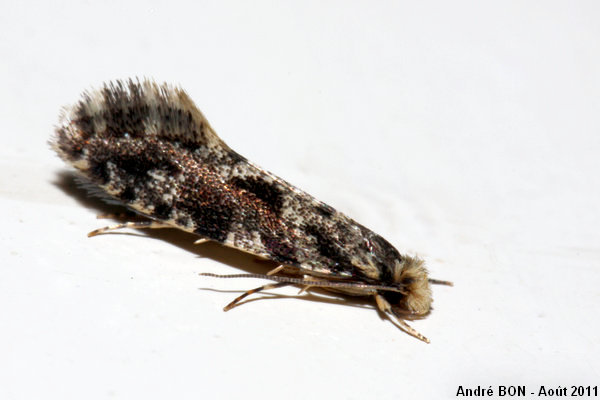
| White-speckled Clothes Moth (Nemapogon wolffiella (Karsholt & Nielsen, 1976)) |

|
|
Scientific name: Nemapogon wolffiella (Karsholt & Nielsen, 1976) Common name: White-speckled Clothes Moth French name: Order: Lepidoptera Suborder: Microlepidoptera Family: Tineidae Subfamily: Nemapogoninae Wingspan: 10-15 mm. Biotope: Woodland areas with many dead trees. Geographic area: Western Eurasia, including northern countries. Flight time: April to August. Number of generations : 1 Caterpillar: White with a brown head. Host plant: Fungi growing on dead wood like the Birch Polypore (Piptoporus betulinus) for example. |
Moths of the Nemapogon genus show the typical shape of the Tineidae family with their wings positioned as a roof shape, the fringe up. The head is covered with a tuft of hairs. The wings are marbled with white and brown. The species are very similar and difficult to tell apart on pictures. Nemapogon wolffiella has its fore wings marbled with white and with shiny dark brown. There are large dark brown patches giving an overall rather dark colour. The hind wings are pale grey. The tuft of hairs on the head is yellowish. The antennae are longer than one half of the wings. The costal edge of the fore wings show six rather well delimited white marks. The three ones close to the apex are curved and hook-shaped. Nemapogon wolffiella is active during the night and attracted to light. Nemapogon cloacella is a slightly paler overall colour. The wings are marbled with dark brown, with white and with paler yellowish brown. I have read that the white patches on the costal edge are not so well delimited but this seems to me rather difficult to evaluate. Nemapogon ruricolella also shows pale brown marks, especially near the tip of the wings. Nemapogon variatella has thinner wings and the tuft of hairs on the head is a pure white colour. |
| [To know more about White-speckled Clothes Moth] [Top] |

|
The dark colour, the shiny dark brown marks, some of them being rather large, the white marks on the costal edge seem to indicate the Nemapogon wolffiella species. |